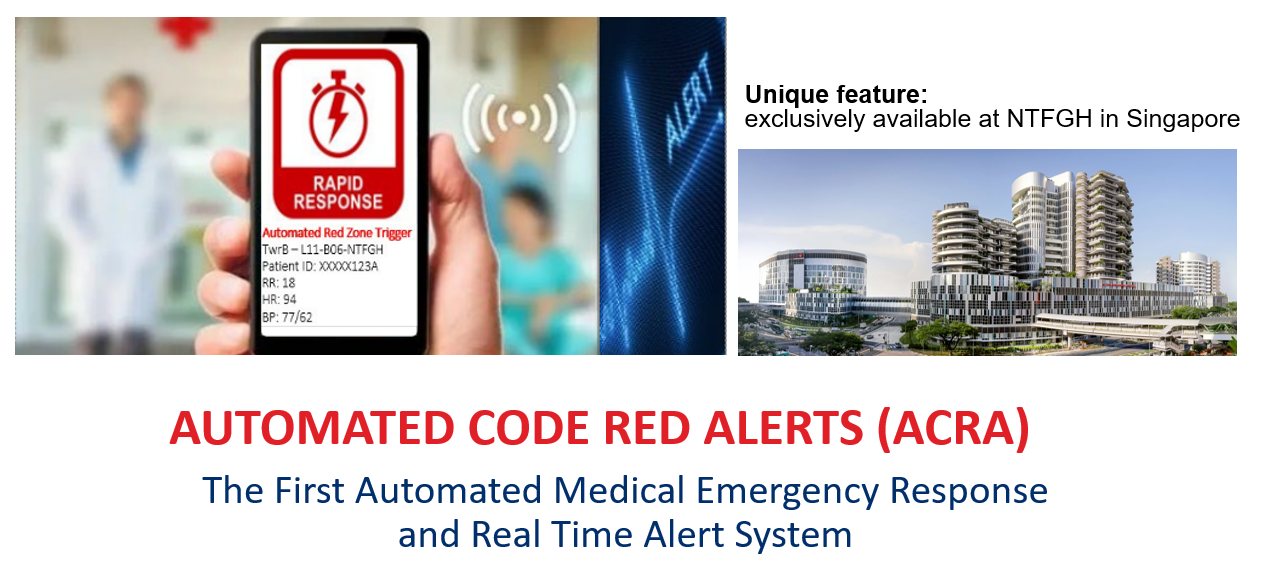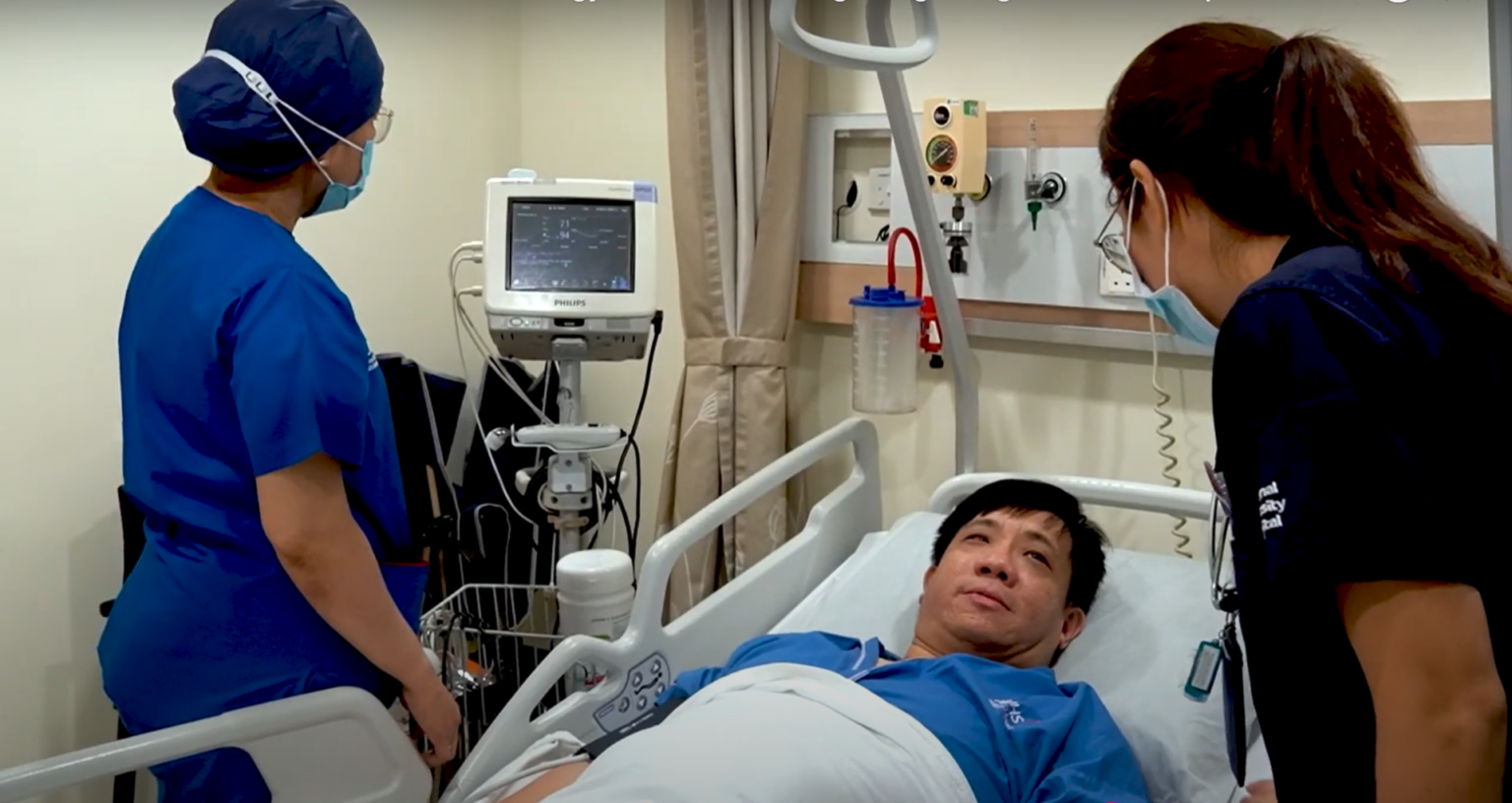Advancing critical care through automation: Ng Teng Fong General Hospital’s pioneering ACRA and ICUORN system
)
The ACRA automated system tracks patient vital signs in real-time, enabling early detection of deterioration and timely interventions.
For patients hospitalised in general wards (GWs), constant monitoring of vital signs is crucial. Persistent changes in vital signs – respiration rate, oxygen saturation, systolic blood pressure, pulse rate, level of consciousness/confusion, and temperature – are signs of patients’ unstable conditions and their heightened risk of severe adverse outcomes.
Traditionally, vital signs were monitored manually by nurses during routine checks. However, there is a risk of subtle changes in vital signs being inadvertently overlooked, resulting in delays in medical intervention and further deterioration in patient conditions.
Singapore’s Ng Teng Fong General Hospital (NTFGH) led an internal review on factors contributing to this risk, which included inexperience in recognising potentially critical changes in vital signs, lack of adequate response from clinicians, and insufficient support from ICU nurses.
Enhancing early identification and treatment of deteriorating patients
To overcome these challenges and enable timely identification of, and response to, clinical deterioration, NTFGH introduced an innovative Automated Code Red Alert (ACRA) system, alongside the ICU Outreach Nursing (ICUORN) service.
The first-of-its-kind amongst local public healthcare institutions, ACRA is an automated clinical deterioration notification system, which monitors patients’ vital signs in real-time and generates alerts when their conditions deteriorate. It is integrated with National Early Warning Score 2 (NEWS2), a scoring system that assesses a patient’s physiological state and identifies potential deterioration based on their vital signs. NTFGH’s Clinical Responses to NEWS2 Trigger Thresholds (CRNTT) policy clearly outlines the responses (escalation protocols, frequency of monitoring, etc) to be taken for each NEWS2 score.

When a patient’s condition enters the critical “red zone” – for example, when their NEWS2 score is above 10 – the system automatically triggers alerts to the ICUORN team via secured mobile devices.
Introduced alongside the ACRA system, the ICUORN initiative involved job redesign and upskilling of experienced ICU nurses, who go on to staff a 24/7 service responding to alerts of deteriorating general ward patients. They play a crucial role in bridging the gap between general ward and intensive care, offering on-site critical care support to minimise preventable morbidity and mortality.
“This streamlined approach ensures timely, efficient communication without using phone calls to response to critical events, supporting accurate severity measurement and rapid response to changes in patient condition,” said NTFGH.
A multidisciplinary team, comprising ICU specialists, clinicians, advanced practice nurses, ICU nurses, medical informatics experts, engineers, and facilities management officers, was established to oversee the integration of these innovative solutions into existing hospital systems and processes.

Impactful results on patient safety and outcomes
With ACRA and ICUORN, the hospital has strengthened its rapid response system (RRS), integrating all four components of a successful RRS. These are namely:
- Clear policies such as the code blue system and CRNTT to guide nurses in identifying deterioration;
- ICUORN responding to deterioration alerts outside of the ICU;
- Administrative oversight of the process, and relevant data collection;
- Patient safety and quality improvement through continuous feedback and outcome tracking to refine care delivery.
The impact of the ACRA-ICUORN initiative has been both measurable and meaningful.
NTFGH noted that clinician compliance with notifications rose from 0–15% to 100%, ensuring timely care escalation. Meanwhile in-hospital cardiac arrest (IHCA) rate dropped from 1.42–1.46 per 1,000 patient days to 1.17. In a survey of nurses, over 80% of respondents agreed that ICUORN interventions were critical in preventing cardiac arrests and patient deterioration.
The system also reduced the number of unnecessary admissions to ICU/High Dependency (HD) units. Only 8% of patients flagged by ACRA required transfer to ICU or HD units, as early intervention in the GW allowed patients to be stabilised so they do not need to be admitted to higher acuity care areas.
Following the success of this project, the hospital has launched a new initiative called TELE-NIV, led by the Respiratory Therapy Department. This system allows respiratory therapists to monitor patients’ vital signs and ventilator data concurrently. Like ACRA, TELE-NIV sends automatic alerts to respiratory therapists if it detects deterioration in the patient’s respiratory status or technical issues with the ventilator.
In conclusion, the ACRA and ICUORN initiatives showcased how timely, tech-enabled interventions can save lives, reduce strain on critical care resources, and create a safer, more responsive healthcare environment.
Said the hospital: “Our project demonstrated ability to improve healthcare outcomes and address pressing clinical challenges. ACRA provides timely deterioration notification and enhances effective communication without phone calls for escalation. Together with ICUORN, this comprehensive technology approach reduces preventable adverse events and mortality.”
“The optimised utilisation of ICU/HD beds through ACRA and ICUORN reduced healthcare costs. At the same time, the collaboration between ICUORN and ward physicians enabled the right level of care to be provided based on patient needs while managing bed capacity. This improved hospital efficiency and patient outcomes.”

